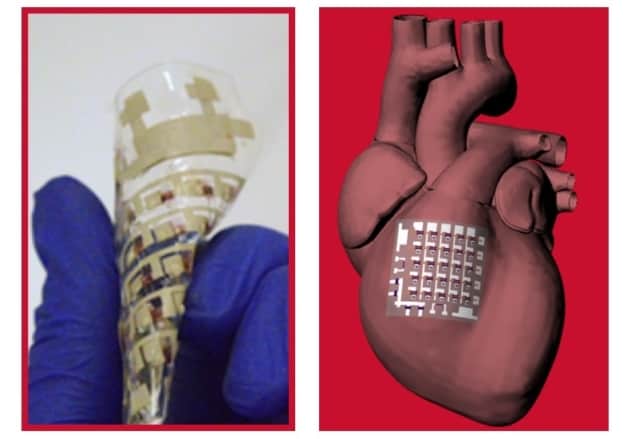
Researchers from the University of Houston, the Texas Heart Institute and the University of Chicago have developed an implantable rubber patch that can collect information about the heart and use it to diagnose cardiac conditions.
Many cardiac devices, such as pacemakers, are limited in one of two ways. They are either made using rigid materials and unable to conform to the complex surface of the heart, or they are flexible but limited in function.
This new device is made from fully rubbery materials and can be placed directly on the heart. It can record data whilst bending with a beating heart. This marks the first time that bioelectronics have been developed based on rubbery materials with similar mechanical properties to the tissues in the heart.
Multifunctional implant
The device has several functions and can both collect information to diagnose conditions and carry out therapeutic functions. It does not need an external power source as it uses energy collected from the beating of the heart.
The implant can monitor tissue strain and temperature, as well as measure electrophysiological activity, all of which are important factors that can help diagnose a variety of heart conditions. Importantly, this device can simultaneously collect this information from multiple regions across the heart to fully map the extent of any problem. In addition to monitoring the heart, the device can also electrically pace it and perform thermal ablation to destroy damaged tissues.
The device itself is a thin elastic electronic sheet that is only 0.4 mm thick. It is based entirely on rubbery materials, from the substrate to the semiconductors. The main base of the device is PDMS (polydimethylsiloxane), a common, low-cost flexible material.
The device can be bent, stretched and crumpled without suffering any damage. In fact, it can be stretched by up to 30% and still function. As the mechanical properties of the implant are similar to those of cardiac tissue, the device can have a close interface with the heart, and the risk that the implant could damage the heart is reduced.
Flexible futures
This device is not meant to be a long-term implant, but rather a temporary diagnostic measure. With an extensive knowledge of how the heart is functioning, doctors can better diagnose and treat cardiac disorders. It could even help speed up the development of new treatments.
“Unlike bioelectronics primarily based on rigid materials with mechanical structures that are stretchable on the macroscopic level, constructing bioelectronics out of materials with moduli matching those of the biological tissues suggests a promising route towards next-generational bioelectronics and biosensors that do not have a hard-soft interface for the heart and other organs,” the researchers write.
Details of the implant are reported in Nature Electronics.



